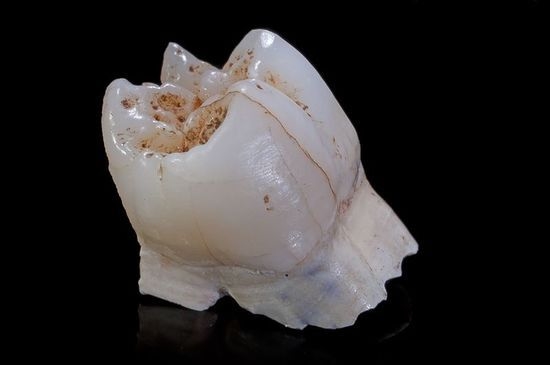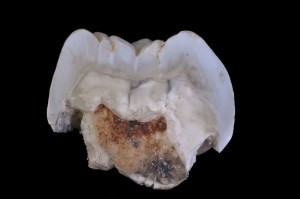Tooth Chemistry Confirms Early Homo Loved Meat
Two million years ago hominids evolved more specialized diets with early Homo preferring meat and Paranthropus choosing plants
![]()

The chemistry of early Homo teeth reveals that the hominid ate more meat than Paranthropus did. Image: José Braga and Didier Descouens
Paranthropus and Homo both emerged in South Africa roughly 1.8 million years ago and lived side by side for several hundred thousand years. Differences in their diet have been used to explain why the Homo lineage succeeded while Paranthropus died out. Now, new chemical analyses of fossil teeth further confirm that the two hominids dined on different foods, with Homo eating more meat than Paranthropus. But even with these differences, the two genera appeared to have ranged over the South African landscape in similar ways.
Scientists have several methods to reconstruct the meal choices of ancient animals.
They can look at the size and shape of the teeth, jaw and skull and look at the diet of modern animals with similar characteristics. They can also observe the microscopic scratches and pits on a tooth’s chewing surface to determine how hard or abrasive one’s diet was. A third option is to investigate the chemistry of an individual’s teeth and bones, which is derived from the chemistry of what the animal ate.
Vincent Balter of Ecole Normale Supérieure de Lyon in France and colleagues selected the third method for their research, published last week in Nature. They analyzed the dental chemistry of seven Paranthropus robustus specimens, three early Homo specimens (species not known) and four members of Australopithecus africanus, which lived lived in South Africa 3.3 million to 2.1 million years ago. All of the teeth came from the famous cave sites of Sterkfontein, Swartkrans and Kromdraai.

A Paranthropus molar. Image: José Braga and Didier Descouens
Using a laser, the team removed tiny amounts of the dental enamel to measure strontium, barium and calcium isotopes. (Isotopes of an element have different numbers of neutrons.) The ratio of these isotopes tend to change as you go up the food chain. Low barium-to-calcium or strontium-to-calcium ratios, for example, are typical of carnivores. John Hawks has a good explanation of how anthropologists use such ratios to examine diet on his blog.
Looking at these isotope ratios, a clear pattern emerged. Meat was a large component of Homo‘s diet whereas plants were a big part of P. robustus‘ diet. These results are in line with previous studies. A. africanus ate both types of food. The researchers speculate the species probably ate a lot of “woody” plants (fruits and leaves, not grasses) during certain seasons and meat during other times of the year, although they can’t say which foods were eaten during which seasons. Taken together, these results suggest earlier hominids were generalists, and then around two million years ago, they began to specialize more. The addition of meat in Homo‘s diet may have allowed our ancestors to evolve big brains, which require a lot of energy to support.
The team also looked at a third isotope ratio, strontium-87 to strontium-86. Strontium isotopes vary by the geology of the local bedrock, so variations in this isotope ratio indicate hominids were eating foods in different locations. These ratios were pretty much the same for all three hominid species, suggesting they all had similar home ranges. So even though Paranthropus and Homo had different diets, they traveled around in similar areas and traversed similar amounts of territory.
To get an even better look at how diets changed with the origin of Homo and Paranthropus, Balter and his colleagues suggest similar tests should be conducted on the teeth of Australopithecus sediba—the 1.97-milion-year-old species that some anthropologists say is a candidate for the ancestor of Homo.
/https://tf-cmsv2-smithsonianmag-media.s3.amazonaws.com/accounts/headshot/science-erin-wyman-240.jpg)
/https://tf-cmsv2-smithsonianmag-media.s3.amazonaws.com/accounts/headshot/science-erin-wyman-240.jpg)